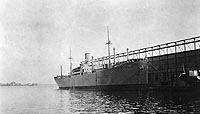
U.S. NAVY TEMPORARY AUXILIARY SHIPS, 1917-1919
WORLD WAR I ERA TRANSPORTS --
Converted Freighters of the 1916-1919 Luckenbach Steamship Company
Type
Ten of the U.S. Navy's WWI era transports were converted from freighters originally constructed in 1916-1919 for the Luckenbach Steamship Company. Of three different, but similar, designs, these were handsome and distinctive ships that, except for their "plumb" bows, looked much like freighters built a generation later. Long oval cutouts in the sides of their blocky midships superstructures provide an excellent way to differentiate them from their more prosiac contemporaries.
Six of these ships, all bearing the names of Luckenbach family members, entered U.S. Navy service in 1918 and operated as freighters until late in that year or early in 1919. They were then modified for troop transport duties, with externally visible additions including portholes in hull sides and temporary houses installed on the decks aft of, and in some cases, in front of the superstructure.
The other four, all built at Chester, Pennsylvania, were not completed until 1919 and were converted to transports at that time. Initially, they had names that probably were assigned by the U.S. Shipping Board, but at least three received typical Luckenbach names after completing their Navy service.
This page features a table (with links to individual ships) of World War I era U.S. Navy transports converted from freighters of the 1917-1919 Luckenbach Steamship Company Type, plus a photograph of each ship in this group.
Click the small photographs to prompt a larger view of the same image with a descriptive header.
Ships in this group:
TEN SHIPS, all having a single smokestack and flush-deck hulls with low bulwarks forward, amidships and aft. They had cruiser sterns and distinctive oval cutouts in the sides of block superstructures two levels high (plus pilothouse). Arrangement of masts, kingposts and smokestacks separates ships constructed by different builders:
Five ships, built by the Fore River Shipyard (Bethlehem
Steel Co.) at Quincy, Massachusetts.
Their dimensions indicate that they were of two different, but virtually identical designs.
All served as U.S. Navy cargo ships before conversion to transports.
Arrangement of kingposts, masts and smokestacks (funnels): K-M-K-F-K-M-K:
 |
 |
 |
Four ships, built by the Sun Shipbuilding Company at Chester, Pennsylvania.
All entered U.S. Navy service as transports. All kingpost tops are fitted with ventilation cowls.
Arrangement of kingposts, masts and smokestacks (funnels): K-KM-K-F-K-KM-K:
One ship, built by the Seattle Construction and Dry Dock Company at Seattle, Washington.
Served as a U.S. Navy cargo ship before conversion to a transport.
Arrangement of kingposts, masts and smokestacks (funnels): K-K-K-F-K-K-K:
Note: Another Luckenbach Steamship Company freighter also served as a U.S. Navy Transport. However, her appearance was significantly different from the ships listed above. Accordingly, USS Edgar F. Luckenbach is treated in the Miscellaneous and Unidentified Types section of this presentation.






